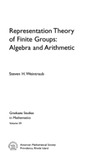Representation theory plays important roles in geometry, algebra, analysis, and mathematical physics. In particular, it has been one of the great tools in the study and classification of finite groups. The theory contains some particularly beautiful results: Frobenius's theorem, Burnside's theorem, Artin's theorem, Brauer's theorem — all of which are covered in this textbook. Some seem uninspiring at first but prove to be quite useful. Others are clearly deep from the outset. And when a group (finite or otherwise) acts on something else (as a set of symmetries, for example), one ends up with a natural representation of the group.
This book is an introduction to the representation theory of finite groups from an algebraic point of view, regarding representations as modules over the group algebra. The approach is to develop the requisite algebra in reasonable generality and then to specialize it to the case of group representations. Methods and results particular to group representations, such as characters and induced representations, are developed in depth. Arithmetic comes into play when considering the field of definition of a representation, especially for subfields of the complex numbers. The book has an extensive development of the semisimple case, where the characteristic of the field is zero or is prime to the order of the group, and builds the foundations of the modular case, where the characteristic of the field divides the order of the group.
 |
|
О проекте
|
|
О проекте


